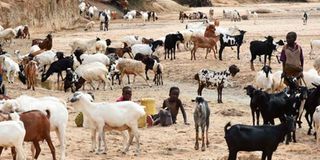Premium
The killer disease ravaging goats and sheep in Turkana, West Pokot

The disease is highly contagious, with between 80 percent and 100 percent mortality rates in acute cases.
West Pokot and Turkana counties are changing their strategies on tackling an endemic disease affecting goats and sheep.
Peste des petits ruminants (PPR) disease, also known as ovine rinderpest, is characterised by cough, pneumonia, and diarrhoea.
It is highly contagious, with between 80 percent and 100 percent mortality rates in acute cases.
Turkana Pastoral Economy Executive Philip Aemun said that the county was embracing a multifaceted approach involving the private sector, local agro vets and community livestock disease reporters, as it seeks to meet the goal of global eradication by 2030.
A county free of PPR, he said, will help tackle poverty and vulnerability among locals, most of whom rely on goats and sheep for their livelihoods.
"Due to the vastness of the county, a shortage of vaccines, livestock movement across county (and country) borders … as well as mostly logistical challenges in carrying out vaccinations remain the main obstacles for PPR prevention and control," he said.
With the help of local disease reporters and support from relevant government agencies and development partners, he said, the county will fully embrace a well-coordinated vaccination drive against PPR.
Mr Aemun said they will work with local agrovets to strategically invest in PPR vaccine banks so as to provide pastoralists with timely and affordable access to high-quality vaccines.
He said the endemic disease and the drought are the greatest threats to livestock in arid and semi-arid areas of Kenya.
But the biggest weapon for the two counties is vaccination.
Last week, the United States pumped 2.5 million euros (Sh323 million) into a vaccination programme against the disease.
USAid, through the Tufts and Florida universities, will lead the four-year free vaccination programme, called the Vaccine Achievement Award. It targets areas on the Kenya-Uganda border, North Pokot and Central Pokot sub-counties.
Phase one of the programme will use 500,000 doses of the PPR vaccines.
Tufts University veterinarian Jeffrey Mariner said that the programme seeks to curb the spread of diseases that are rampant in the region.
The new model, he said, will focus on engaging with community-based stakeholders and offering capacity building for cattle keepers so that they can vaccinate their livestock themselves.
“It will incorporate farmers who will vaccinate their livestock. The new model shall use a combination of tools and approaches, which proved successful in the rinderpest eradication, including the thermostable vaccine, community participation, and use of modelling to target areas with the highest disease transmission,” said Mr Mariner, who said a similar programme was underway in 62 other countries.
Speaking on Thursday in Kamla, Kacheliba, North Pokot sub-county, during the planning meeting and training of farmers, West Pokot County veterinary services Director Samuel Chelimo said they want to achieve over 80 per cent vaccination of goats and sheep.
Re-emergence of diseases
“We are using village elders, chiefs, assistants, ward administrators, assistant county commissioners and other stakeholders. We shall deliver the vaccines to the farmers,” he said.
Dr Chelimo said that they are targeting cross-border areas and North and Central Pokot sub-counties.
“This disease is bad because it wipes out all livestock and we must control it,” he said.
In Turkana, the director of veterinary services, Dr Benson Long'or, said that with support from Vétérinaires sans Frontìeres Germany (VSF-G) through funding from the European Union Trust Fund a strategic drug store was established in Lokamarinyang village, near the Kenyan border with Ethiopia, to ensure strategic prepositioning of livestock drugs and vaccines along migratory routes.
Dr Longor said the store seeks to enhance response and control of diseases on the border with large herds of livestock in the village, which is also near Kenya’s border with South Sudan and a strategic livestock migratory route recognised by the Intergovernmental Authority on Development (Igad) and the Centre for Livestock Development.
"The store is located in a village with a high concentration of all kinds of livestock, including goats, sheep, cattle, donkeys and camels, and when they come into close contact during drought or as a result of insecurity there is always the emergence or re-emergence of diseases like PPR. More investment in such drug stores with cold chains for storing vaccines will be critical," he said.
Silo Agrovet proprietor Elizabeth Lokolio, who is managing the drug store under a public-private partnership, said that pastoralists have had difficulties accessing drugs from Lodwar or Kakuma or fall victim to quack vets who sell substandard drugs.
She said that if more drug stores are decentralised at known migratory routes, with proprietors working closely with veterinary officers to offer extension services, pastoralists will be assured of quality animal health services to safeguard livelihoods.
Kibish sub-county peace building officer Achegei Abdi Adan welcomed the move, noting that conflict over pasture and water on the border of Kenya and Ethiopia has been a major hindrance to disease control.
To embrace the initiative, the county government and local authorities in Ethiopia are banking on elders who have established peace committees to embrace homegrown solutions and weed out rivalry to attract government services like livestock vaccination and treatment.
Speaking at an event in Kangaten Warida, Ethiopia, that was supported by the Turkana County government and Pact International, Mr Adan urged the Nyangatom and Turkana communities to end animosity and embrace peace as the key component of transformative development.
County Secretary Peter Eripete said peace and healthy livestock will translate to cross-border trade that will open the Kenya-Ethiopia border to meaningful development.
Lokori/Kochodin, Kapedo/Napeitom and Katilia wards in Turkana East sub-county were singled out as the latest areas hit by the disease.
Simon Pringan, a herder in Ngilukia village, said that he had lost 22 goats to the disease, which he said was characterised by fever, coughing, sores in the mouth, diarrhoea and pneumonia.
Some of the goats had discharges from the eyes and nose, which sometimes formed a crust, making breathing difficult and forcing eyes shut.
The county government, in a partnership with USAid’s Feed the Future and the International Livestock Research Institute, has issued smartphones to disease reporters as part of an innovative community-led syndromic livestock disease surveillance.





